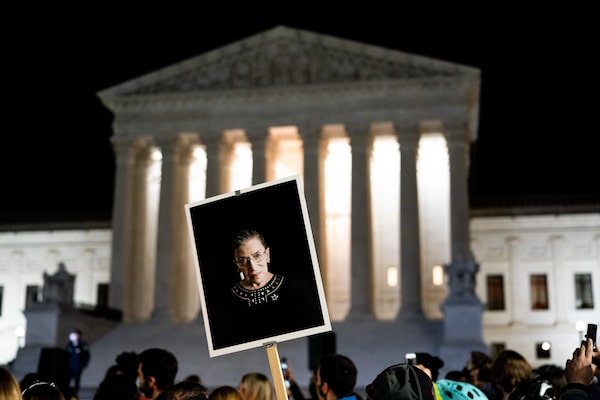
A person holds a sign with a photo of the late Justice Ruth Bader Ginsburg at a vigil in her honor outside the Supreme Court in Washington, on Sept. 19, 2020.Anna Moneymaker/The New York Times News Service
Rosalie Silberman Abella is a Supreme Court of Canada Justice.
My friend, the incandescent Ruth Bader Ginsburg, was a jurist, a woman and a Jew. It was a defining combination that shaped her values, her passions and her vision, transforming her from distinguished Supreme Court Justice to iconic global metaphor.
She represented the aspirations of a new generation of women in the 1970s when she co-founded the Women’s Rights Project at the American Civil Liberties Union and argued for gender equality before the Supreme Court; carried the feminist message into that court when she joined it in 1993; and developed it into a wider embrace of human rights during her supreme tenure. By the time she died on Sept. 18, she was the most recognized judicial name in my lifetime.
Hers was a remarkable but by no means predictable professional trajectory. At a time when women – rightly – considered themselves unwelcome as members of the legal profession, she went to law school. At a time when even if you became a lawyer, getting married – let alone having children – represented a choice that was seen to reflect an attenuated loyalty to your professionalism, she revelled in her marriage and parenthood. At a time when being Jewish – let alone Jewish and female – was a dubious calling card for employers, she embraced both exuberantly. At a time when being a feminist was seen as an assault on men and the status quo, she coaxed the law into an understanding that women had the same right to the status quo’s choices as men. Then she changed the status quo.
It’s hard to remember that there was a time when women like Justice Ginsburg had to figure out how to make the case for equality compelling; had to explain that women had the same right as men to work, to be paid fairly, to be free from violence and poverty, and to aspire; had to explain that there are not two sides to the case for equality, unless inequality is treated as a valid rebuttal; and had to explain that being fair to women is not being unfair to men – it is catching up.
Before there were widely publicized strategies for how to make your voice heard, your invisibility visible, your fears compartmentalized and your anger constructive, Justice Ginsburg followed the path illuminated by her own dreams, walked right past the censorious, the skeptical and the cynical, and cleared the path for others. She leaned in, she leaned out and she leaned up, but she never leaned down, except to help others.
When she pursued justice on the Supreme Court, she was not only a judge, she was a judicial juggernaut who was catapulted into international orbit. And what catapulted her was the combination of a public responding with enthusiastic gratitude to her ever bolder judgments, and, on the other hand, the vituperative reaction of an increasingly regressive climate in which those progressive judgments were anathema.
The critics made their arguments skillfully. They called the good news of an independent judiciary the bad news of judicial autocracy. They called women and minorities seeking the right to be free from discrimination, special interest groups seeking to jump the queue. They called efforts to reverse discrimination, “reverse discrimination," or a violation of the merit principle, or political correctness. They said courts should only interpret, not make law, thereby ignoring the entire history of common law. They called advocates for diversity “biased” and defenders of social stagnation “impartial.” They claimed a monopoly on truth, frequently used invectives to assert it, then accused their detractors of personalizing the debate. They said “feminist” was the scariest word in the English language, replaced ideas with ideology, and substituted analysis with labels such as “activist” or “legislators in robes” or “anti-democratic.” This is the context in which Justice Ginsburg became a luminous avatar.
For her, there was no justice without respect for rights, no respect for rights without access to inclusion and no access to inclusion without compassion. Through her, the public saw how fragile the safety of their rights could be, and lionized her for recognizing the moral and social cost of injustice. And through her, the public saw how empathy and courage could vitalize judicial independence. When she wrote for the majority, as she did in striking down the all-male admission policy at Virginia Military Institute, she was leading the way. When she wrote in dissent, she was leading the resistance.
As human rights are being rolled back or cavalierly politicized in so many parts of the world, a world where the vulnerable have become more vulnerable, where prejudice poisons, hate kills, truth is homeless and lives don’t matter, is it any wonder that Justice Ginsburg’s legacy is so preternaturally cherished as a rebuke to all of the above? She is a reminder that democracy does not just depend on the will of the people, but on their humanity. And as someone who kept trying to protect their humanity, one dissent at a time, she is a reminder not only that justice is of the people and for the people, but that judges, at their best, will deliver it to them with fearless wisdom and transcendent hope.
Keep your Opinions sharp and informed. Get the Opinion newsletter. Sign up today.